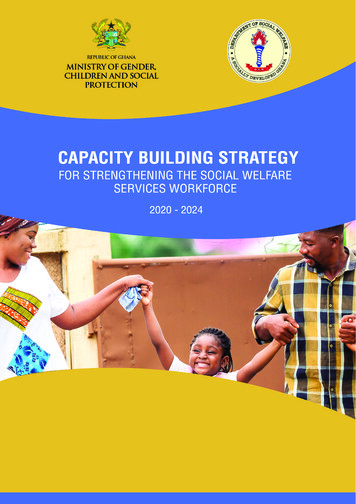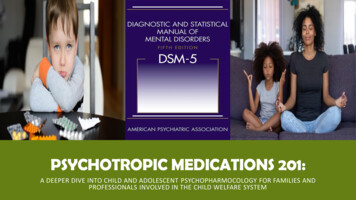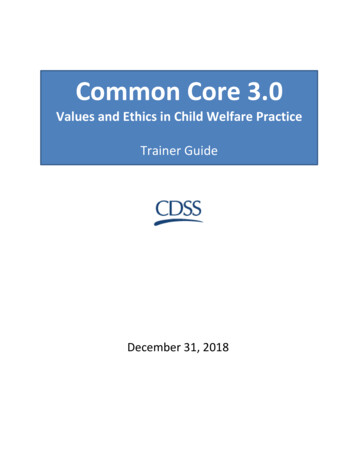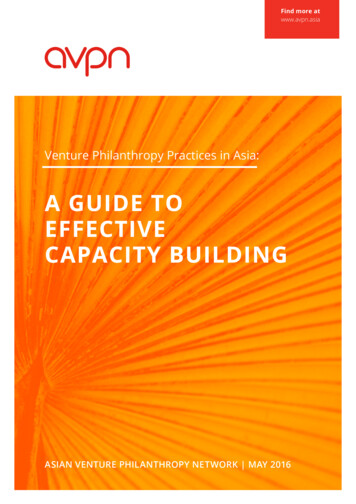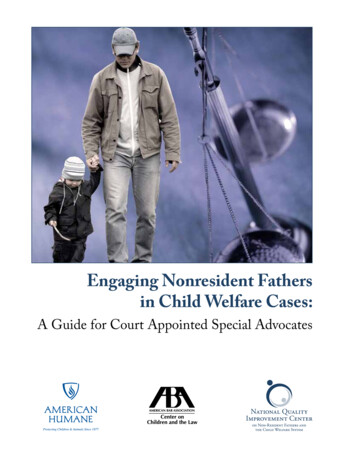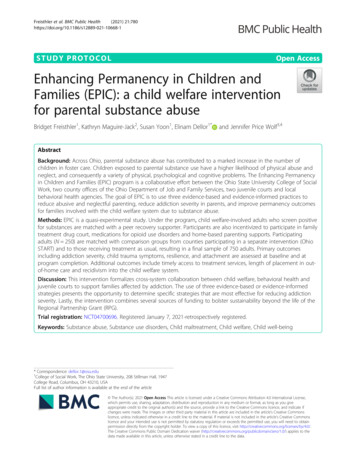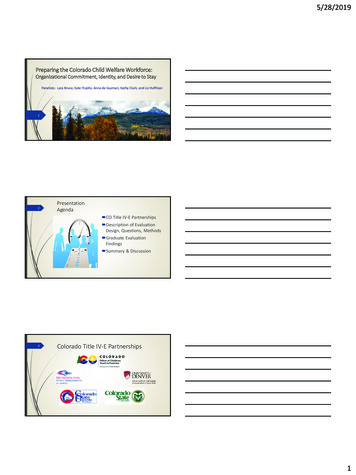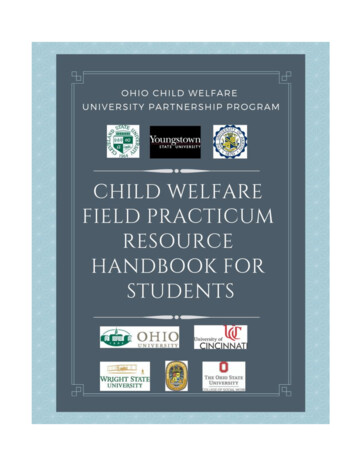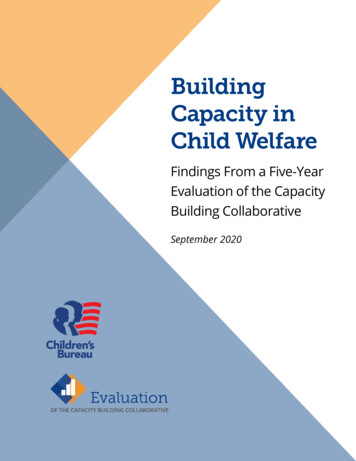
Transcription
BuildingCapacity inChild WelfareFindings From a Five-YearEvaluation of the CapacityBuilding CollaborativeSeptember 2020
Building Capacityin Child WelfareFindings from a Five-Year Evaluationof the Capacity Building CollaborativeAcknowledgmentsThis report was developed by James Bell Associatesand ICF on behalf of the Children’s Bureau,Administration for Children and Families (ACF),U.S. Department of Health and Human Services(HHS), under contract number HHSP233201400026C.Its contents are the sole responsibility of the authorsand do not necessarily represent the official viewsof the Children’s Bureau, ACF, or HHS. For moreinformation, see https://capacity.childwelfare.gov/.Suggested citationJames Bell Associates and ICF. (2020). Building capacityin child welfare: Findings from a five-year evaluationof the Capacity Building Collaborative. Children’sBureau, Administration for Children and Families,U.S. Department of Health and Human Services.
ContentsExecutive SummaryCollaborative Service TypesData CollectionKey FindingsImplications of the EvaluationSection 1. BackgroundChildren’s Bureau Child Welfare Capacity Building CollaborativeCollaborative Service TypesChildren’s Bureau ExpectationsChange Management and Implementation ApproachChange Management and Implementation and Capacity OutcomesSection 2. Cross-Center Evaluation of theCapacity Building CollaborativeEvaluation Methodsivvvivix12455677Section 3. Services Delivered by the Centers11Universal and Constituency ServicesTailored Services Received by Jurisdictions1114Section 4. Satisfaction With and Outcomes of Center ServicesFactors That Influenced the Use of Center ServicesSatisfaction With Universal and Constituency ServicesSatisfaction With Assessments and Work PlanningSatisfaction With Tailored ServicesNature and Quality of Relationship With CentersOutcomes Achieved in JurisdictionsSection 5. Implications of This EvaluationImplications for Centers and JurisdictionsImplications for Future Evaluations of Capacity Building rganizational Capacity Dimensions and SubdimensionsService Delivery Types4548Building Capacity in Child Welfare: Findings From a Five-Year Evaluation of the Capacity Building Collaborativeii
ExhibitsExhibit 1. Organizational Capacity Dimensions3Exhibit 2. Collaborative Service Types4Exhibit 3. Change Management and Implementation Approach5Exhibit 4. Evaluation of the Capacity Building Collaborative Logic Model8Exhibit 5. Evaluation Data Sources9Exhibit 6. Common Topics of Universal and Constituency12Products and ServicesExhibit 7. Percentage of CIP Needs Identified Through Self-Assessment16Exhibit 8. Center for Courts Direct Project Contact Hours, by CIP18Exhibit 9. Center for States Direct Project Contact Hours, by State/Territory19Exhibit 10. Project Spotlight21Exhibit 11. Center for States Child and Family Services Review and Program24Improvement Plan Development Contact Hours, by State/TerritoryExhibit 12. Center for Tribes Direct Project Contact Hours, by Tribe25Exhibit 13. Characteristics of Centers’ Tailored Services27Exhibit 14. Percentage of Project Hours, by Implementation Phase and Step28Exhibit 15. Percentage of State and Tribal Needs, by Capacity Dimension29Exhibit 16. Factors That Influenced the Use of Center Services, 201932Exhibit 17. Likelihood of Using Change and Implementation Process Again34Exhibit 18. Director Satisfaction With Relationship With the Centers34Exhibit 19. Percentage of Instances in Which Project Teams Reported anIncrease in Targeted CapacityExhibit 20. Number of Capacity Dimension Outcomes Reported Achievedand Not Achieved by Project Closure, Across all CentersExhibit 21. Percentage of Instances in Which Project Teams Reported anIncrease in Change Management-Related Knowledge and SkillsExhibit 22. Number of Milestones Reported Achieved and Not Achievedby Implementation Step, for all Centers36Exhibit 23. Factors Associated With Achievement of Outcomes40363738Building Capacity in Child Welfare: Findings From a Five-Year Evaluation of the Capacity Building Collaborativeiii
Executive SummaryThis report presents findings from an evaluation of the services delivered by the ChildWelfare Capacity Building Collaborative (Collaborative) funded by the Children’s Bureau (CB),Administration for Children and Families, U.S. Department of Health and Human Services.CB established the Collaborative in 2014 to help state and tribal child welfare agencies andCourt Improvement Programs (CIPs) meet federal mandates; enhance child welfare practices;and improve child and family outcomes related to safety, permanency, and well-being. TheCollaborative is a partnership among three Capacity Building Centers (the Centers): the Centerfor Courts, the Center for States, and the Center for Tribes. Building on lessons learned fromits previous training and technical assistance network, CB restructured its service providers toimprove efficiency and promote consistent service delivery (Child Welfare Capacity BuildingCollaborative, 2015) via common processes and practices.Building Capacity in Child Welfare: Findings From a Five-Year Evaluation of the Capacity Building Collaborativeiv
Covering federal fiscal years (FYs) 2015 through2019, the findings here stem from the cross-centerevaluation conducted by a team of externalevaluators led by James Bell Associates and ICF.Included are the types of capacity building servicesoffered, the common service delivery approach theCenters used, and efforts to collaborate within andacross Centers. This report details the universal andconstituency products and services developed anddisseminated by the Centers, the tailored servicesCenters provided to CIPs and state and tribal childwelfare agencies, and the evaluation and outcomesof these services. The report also examines factorsthat influenced jurisdictions’ decision to useservices, their satisfaction with Center services, thenature and quality of relationships between Centerservice providers and recipients, and the outcomesof services. Finally, the report explores implicationsfor future work by the Collaborative and for evaluation processes. Although the multimethodevaluation examined capacity building services designed for child welfare systems, includingthe courts, some of the lessons learned may be useful for program administrators, evaluators,and service providers in other fields.Collaborative Service TypesEach Center in the Collaborative serves a target audience, maintains its own administrativestructure, and conducts its own evaluation:Center for States supports state and territorial title IV-B and IV-E public child welfare Theagencies and assisted title IV-E waiver demonstration projects prior to their completion.Center for Tribes serves title IV-B and title IV-E tribal child welfare agencies Theand organizations. The Center for Courts provides services to state and tribal CIPs.All Collaborative services aim to enhance professional skills and build organizational capacitiesof the child welfare system and courts so they can achieve better outcomes for children, youth,and families. The Centers develop and offer three types of services—universal, constituency,and tailored:and constituency services seek to build the capacity of professionals across Universalmultiple jurisdictions. Centers create content and disseminate information and materialsthat are broadly relevant to child welfare and court professionals; they also generatecontent specific to the roles of different stakeholders in the child welfare system.services offer customized support to meet the unique capacity building needs of Tailoredan individual state, tribe, or CIP. Centers partner with jurisdictions and use an assessmentprocess to identify strengths and needs; they then develop a work plan for thosejurisdictions that decide to engage in services. The work plan outlines the activities of thejurisdiction and the services provided by the Center to achieve the desired enhancementsin organizational capacity and practice improvements.Building Capacity in Child Welfare: Findings From a Five-Year Evaluation of the Capacity Building Collaborativev
Data CollectionThe cross-center evaluation used a mixed-methods, longitudinal approach to answer evaluationquestions about the Collaborative’s services. The evaluation design was participatory andutilization-focused, with Center leadership, local Center evaluators, and federal staff activelyinvolved in all phases of the study. Together the team learned what aspects of the evaluationapproach worked well and where improvements could be made in evaluation design,instrumentation, data collection procedures, and analyses.Key FindingsThe cross-center evaluation yielded an array of valuable insights into the functioning andservice outcomes of the Collaborative. The evaluation produced findings on the natureof services provided to jurisdictions,satisfaction with those services, knowledgegained about effective practices in childwelfare, and the extent to which servicesimproved understanding of changemanagement and implementation andsupported capacity building. Eight broadevaluation questions framed a mixedmethod, longitudinal study that drewon multiple data collection strategies tocapture rich quantitative and qualitativeinformation. Some data were collected bythe cross-center evaluation team, whilethe Centers and their evaluators providedother data. A summary of findings from thestudy follows.Universal and Constituency ServicesUniversal and constituency services seek to convey to the field key information on bestpractices in child welfare. Some information and materials target a broad, national audienceof child welfare professionals (universal services), while other services target specific groupsof professionals (constituency services). Universal and constituency services are not tailoredto the needs of a specific jurisdiction. Centers produce three major categories of universaland constituency services: products, events, and learning experiences. To measure outcomesof products and events, the cross-center evaluation team relied on shared datasets of Centeradministered satisfaction surveys. Important findings on universal and constituency services follow: Topics of products and events frequently aligned with Center and CB priorities.and constituency services supported numerous constituency groups, including Universalolder youth, Indian Child Welfare Act specialists, and family leaders. Center learning experiences were accessible to participants via CapLEARN. Centers used a variety of dissemination strategies to promote their products and services.1CapLEARN is a password-protected, searchable site that provides users with a single location for accessingrecorded webinars and learning experiences.1Building Capacity in Child Welfare: Findings From a Five-Year Evaluation of the Capacity Building Collaborativevi
Most universal and constituency services were intended to increase awareness and knowledge.all Centers, most respondents viewed the content of universal and constituency Acrossservices as relevant to the values and context of their agencies and their communities andreported satisfaction with the products and services.experiences yielded participant knowledge gains, as evidenced by results from Learningpre-post knowledge tests administered by two Centers.Tailored ServicesAssessments and Work PlanningTo identify jurisdictions’ strengths and capacity building needs, the Centers engagedjurisdictions in assessments and developed work plans to address jurisdictions’ needs. Keyfindings about assessment and work planning follow:with jurisdiction leadership revealed assessment and work planning services Interviewswere perceived by most respondents as being beneficial.jurisdictions offered recommendations, such as simplifying the work plan, making Somethe work plan more focused, changing the format of the work plan to be more interactive,and reviewing the work plan more frequently.CIPs indicated active involvement in their state child welfare agency’s assessment. FewCIPs reported a desire for more collaboration between states and CIPs.Tailored Services ProjectsFollowing assessment and work planning, Centers engaged jurisdictions in tailored servicesto address the identified capacity needs and support jurisdictions in making organizationalchanges and practice improvements. Key findings about the tailored services follow:Centers delivered most of their direct contact hours in person, which enabled Center staff to useintensive service approaches more readily such as facilitation, coaching, and consultation.focused most direct contact hours on strengthening organizational capacities in Centersthe areas of knowledge and skills, infrastructure, and engagement and partnership.was a particularly effective service strategy: the greater the proportion of direct Coachingcontact hours delivered in the form of coaching, the faster jurisdictions achieved their2implementation milestones.providers and jurisdiction project teams agreed organizational capacity increased Servicein the capacities they targeted in their work plans.Hours of direct contact describe in-person or virtual communication between Center representatives andmembers of a jurisdiction that are intended to build capacity. The hours do not include time spent on indirectactivities, such as preparing for a site visit, planning calls between Center staff and consultants, or activitiesnot intended to build capacity such as making logistical arrangements for onsite visits.2Building Capacity in Child Welfare: Findings From a Five-Year Evaluation of the Capacity Building Collaborativevii
project teams reported increases in their knowledge and skills related to Jurisdictionchange management and the implementation process.providers reported project teams completed most of their targeted milestones by Serviceproject close.outcomes were influenced by the work of the Center service providers and the Projectjurisdictions’ organizational factors and foundational capacity.with stronger foundational capacity were more likely to achieve their Jurisdictionsmilestones than jurisdictions with less capacity.greater number of hours of direct contact was associated with achievement of Amilestonesand capacity enhancement.Building Capacity in Child Welfare: Findings From a Five-Year Evaluation of the Capacity Building Collaborativeviii
CollaborationThe three Centers are expected to collaborate. Collaboration of two or more Centers occurredmost frequently in areas of federal priority and on topics shared by all Centers, such as the IndianChild Welfare Act, continuous quality improvement, and Child and Family Services Review (CFSR).The evaluation revealed collaboration within each Center happened often and was perceivedpositively by Center leadership and service providers:251 products the Collaborative developed, 40 (16 percent) involved collaboration OfwiththeanotherCenter.of these jointly developed products were recorded webinars and resources Manyfrom the virtual expos and included topics most frequently related to safety and riskassessment, permanency planning, recruitment and retention of workforce, andfederal reporting. Centers collaborated on more than one-fourth of tailored services projects.Center for Courts collaborated with other Centers on 40 percent of their tailored Theservice projects.to collaboration across Centers included in-person and regularly scheduled Facilitatorsmeetings and frequent meetings of Center directors.There were, however, barriers to collaboration across Centers including insufficient time tocollaborate, limited opportunities for collaboration, differences in Center size with respect toannual funding and number of employees, insufficient resources to collaborate, and lack ofstructure to facilitate collaboration across Centers.Building Capacity in Child Welfare: Findings From a Five-Year Evaluation of the Capacity Building Collaborativeix
Implications of the EvaluationAlthough this multimethod evaluation involved capacity building services for child welfare, someof the lessons learned may pertain to other fields. Federal, state, tribal, and county programadministrators; evaluators; and providers with other backgrounds may find relevant informationrelated to preparing for and delivering services, facilitators and barriers to accessing capacitybuilding services, and methods for evaluating training and technical assistance services.Implications for the Centers and JurisdictionsThe Centers have benefited from consistently using a common change managementapproach to guide their work, which could be enhanced even further through greateroperationalization and development of more consistent strategies.There appears to be an opportunity for cross-training among Centers on the changemanagement and implementation approach, including opportunities for sharingtechniques and unifying methods.Collaboration could be increased with improved communication and informationsharing across Centers.Centers provided fewer direct contact hours related to the capacity building areas ofculture and climate and resources. Further investigation is needed to understand why.By proactively following up with jurisdictions, Centers would have more opportunitiesto support late-stage implementation efforts, including installation and evaluationof interventions.Coaching was shown to be an effective service strategy; opportunities should beexplored to determine when it can be used more often.If Centers played a more active role in promoting and facilitating collaboration betweenstate agencies and CIPs during a state’s assessment for tailored services, the CIPs couldpotentially enhance their role in state child welfare planning.Implications for Future Evaluations of Capacity Building ServicesFuture evaluators of capacity building efforts should gather more information to assess howwell jurisdictions understand the change management approach and assess its utility as aguiding framework for understanding and approaching capacity building service delivery.Future evaluations of capacity building efforts need to more thoroughly assesstailored services focused on CFSR and Program Improvement Plan development andimplementation.Future evaluations should work to identify opportunities to assess tailored servicesoutcomes related to practice (behavior) change.Building Capacity in Child Welfare: Findings From a Five-Year Evaluation of the Capacity Building Collaborativex
Section 1BackgroundThis report presents findings from a fiveyear evaluation of the Capacity BuildingCollaborative, funded by the Children’s Bureau(CB), Administration for Children and Families,U.S. Department of Health and HumanServices. CB established the Collaborativein 2014 to help state and tribal child welfareagencies and Court Improvement Programs(CIPs) meet federal mandates; enhance childwelfare practices; and improve child and familyoutcomes related to safety, permanency, andwell-being. The Collaborative is a partnershipamong three Capacity Building Centers (theCenters): the Center for Courts, the Center forStates, and the Center for Tribes. Building onlessons learned from its previous training andtechnical assistance network, CB restructuredits service providers to improve efficiency andpromote consistent service delivery (ChildWelfare Capacity Building Collaborative, 2015)via common processes and practices. Coveringfederal fiscal years (FYs) 2015 through 2019,the findings here stem from the cross-centerevaluation conducted by a team of externalevaluators led by James Bell Associates and ICF.From FY 2014 through FY 2019, the CapacityBuilding Collaborative (Collaborative) assisted33 states, 31 tribal, and a few territorial childwelfare systems and more than 50 CourtImprovement Projects3 (CIPs) with assessingand addressing specific issues within theirchild welfare systems through the provision oftailored services.3This includes CIPs in states; Washington, DC; Puerto Rico; and a few territories.Building Capacity in Child Welfare: Findings From a Five-Year Evaluation of the Capacity Building Collaborative1
This evaluation report examines the following: Change management and implementation approach Services delivered by the Centers Use of and satisfaction with Center services Nature and quality of relationship with Centers Outcomes achieved in jurisdictions Implications of the evaluation on the Collaborative Implications of the evaluation on future evaluations of capacity buildingChildren’s Bureau Child WelfareCapacity Building CollaborativeCB, a federal agency within the Administration forChildren and Families, U.S. Department of Healthand Human Services, holds primary responsibility foradministering child welfare programs. These programsseek to protect children from abuse and neglect;strengthen families so they can better meet their child’swell-being needs; and establish permanent connectionsfor children through reunification with their families,when possible, or placement into permanent livingsituations. CB provides guidance, oversight, andsupport so that states, territories, and tribes caneffectively implement federal programs and meetfederal requirements. These requirements may includesupporting and monitoring longstanding provisionsof the Child Abuse Prevention and Treatment Actand titles IV-B and IV-E of the Social Security Act andcommunicating guidelines and ensuring compliance tomandates in recent legislation.To support jurisdictions’ child welfare service deliveryand performance, CB offers training and technicalassistance. In 2014, CB established the Collaborative tohelp state and tribal child welfare agencies and CourtImprovement Programs (CIPs) meet federal mandates;enhance child welfare practices; and improve childand family outcomes related to safety, permanency,and well-being. The Collaborative is a partnershipamong three Capacity Building Centers: the Center forCourts, the Center for States, and the Center for Tribes.Each Center serves a target audience and maintainsits own administrative structure and evaluation team(see sidebar).The Center for Statessupports state andterritorial title IV-B and IV-Epublic child welfare agenciesand assisted title IV-E waiverdemonstration projectsprior to their completion.The Center for Tribesserves title IV-B and title IV-Etribal child welfare agenciesand organizations.The Center for Courtsprovides services tostate and tribal courtimprovement programs(CIPs).Building Capacity in Child Welfare: Findings From a Five-Year Evaluation of the Capacity Building Collaborative2
The Collaborative defines capacity building as “an ongoing, evidence-informed process that isintended to develop a system’s potential to be productive and effective. Capacity can be builtby applying child welfare system’s human and organizational assets to achieve its currentand future goals” (Child Welfare Capacity Building Collaborative, 2015). All Collaborativeservices aim to enhance professional skills and build organizational capacities of the childwelfare system and courts so they can achieve better outcomes for children, youth, andfamilies. A review of the literature supports the concept of organizational capacities acrossfive general dimensions: resources, infrastructure, knowledge and skills, culture and climate,and partnership and engagement (Children’s Bureau, 2016). These organizational capacitiesare defined in exhibit 1. See the glossary for definitions of the child welfare organizationalcapacity dimensions and subdimensions.Exhibit 1. Organizational Capacity DimensionsBuilding Capacity in Child Welfare: Findings From a Five-Year Evaluation of the Capacity Building Collaborative3
Collaborative Service TypesAll Centers in the Collaborative develop and offer three types of services: universal,constituency, and tailored. Universal and constituency services are intended to build thecapacity of professionals across multiple jurisdictions. Centers create content and disseminateinformation and materials that are broadly relevant to child welfare and court professionals(universal services); they also generate content specific to the roles of different stakeholdersin the child welfare system (constituency services). Tailored services offer customized supportto meet the unique capacity building needs of an individual state, tribe, or CIP. Centers partnerwith jurisdictions and use an assessment process to identify strengths and needs; they thendevelop a work plan for jurisdictions that decide to engage in services. The work plan outlinesthe activities of the jurisdiction and the services provided by the Center to achieve the desiredenhancements in organizational capacity and practice improvements. The purpose, audience,and examples of service activities are detailed in exhibit 2.Building Capacity in Child Welfare: Findings From a Five-Year Evaluation of the Capacity Building Collaborative4
Children’s Bureau ExpectationsCB expects the three Centers within the Collaborative to adhere to a single service deliverymodel and share common or similar service planning and delivery procedures, evaluationexpectations, and indicators of target outcomes. CB also expects Centers to avoid unnecessaryduplication of effort and to capitalize on opportunities to design and deliver joint products,training, and other services to common service recipients. The three Centers are expected to—on research-informed frameworks to support child welfare systems with Relyorganizational change, implementation, and continuous quality improvement (CQI). Plan and implement services that are grounded in sound theories of change.and monitor specific and measurable outcomes of their services to promote Identifyaccountability for learning and improvement (Child Welfare Capacity BuildingCollaborative, 2015).Change Management and Implementation ApproachTo ensure consistency when working with jurisdictions, CB outlined a research-informedapproach that synthesizes change management, implementation, and CQI frameworks. Asshown in exhibit 3, the change management and implementation approach has five phases thatresearch suggests will enhance the design, implementation, and sustainability of improvementsto an organization’s practice or policies.Building Capacity in Child Welfare: Findings From a Five-Year Evaluation of the Capacity Building Collaborative5
Although the three Centers all use the change management and implementation approach,they vary in how they apply it. The Center for Courts and Center for States identify wherejurisdictions are in the change management approach, use this information to support workplan development, and then provide support to the jurisdictions throughout the applicablechange management phases. In contrast, all Center for Tribes tailored services start at thebeginning of the change management approach process; then the Center uses assessment andwork planning to systematically work with tribes through phases 1 and 2. If the tribe opts toengage in a project, the Center works with the tribe through phases 3 through 5 of the changemanagement approach.Change Management and Implementationand Capacity OutcomesAs part of the work planning process for each tailored services project, Center staff identifythe outcomes jurisdictions are expected to achieve through Center support. Centers selectthe intended outcomes from among a common set of change management milestones and/or from the list of organizational capacity outcomes. Centers then record these project-specificoutcomes in CapTRACK and indicate the expected date of achievement.CapTRACK is an online tracking system that enables Centers to record dataabout their universal, constituency, and tailored services. CapTRACK capturesinformation about Center products, events, and learning experiences; processesand workflows; and Center tailored services, including the service recipients,service strategies, frequency, modality, topic, and dosage;4 and the expected andactualized outcomes of services. CapTRACK is organized as a series of relatedforms that align with the Collaborative’s service delivery structure for universal,constituency, and tailored services. Each form includes a series of fields thattogether describe the products, events, and learning experiences planned andprovided and the tailored services delivered.Centers select change management milestone outcomes when services support jurisdictionsin their implementation efforts. The milestone outcomes provide a common mechanism for allCenters to measure and assess jurisdiction implementation progress.Some tailored services projects seek to help jurisdictions build organizational capacity relatedto resources, infrastructure, knowledge and skills, culture and climate, and engagement andpartnership. The selection of organizational capacity outcomes varies according to the goalsfor the tailored services projects and jurisdictions’ preexisting capacity. One common outcomeexpected across all tailored services projects is improved knowledge and skills of jurisdictionsrelated to change management and implementation.Dosage is defined as the number of hours of direct contact by Center staff with representatives from ajurisdiction.4Building Capacity in Child Welfare: Findings From a Five-Year Evaluation of the Capacity Building Collaborative6
Section 2Cross-Center Evaluationof the Capacity BuildingCollaborativeCollecting data throughout FYs 2015 through 2019, the cross-center evaluation used a mixedmethods, longitudinal approach to respond to a set of evaluation questions related to Centerservice delivery approach and interventions, satisfaction with Center services, and jurisdictionoutcomes. The evaluation design was participatory and utilization-focused, with Centerleadership, individual Center evaluators, and federal staff actively involved in al
Change Management and Implementation and Capacity Outcomes 6. Section 2. Cross-Center Evaluation of the Evaluation Methods 7. Capacity Building Collaborative 7. . its previous training and technical assistance network, CB restructured its service providers to improve efficiency and promote consistent service delivery (Child Welfare Capacity .
